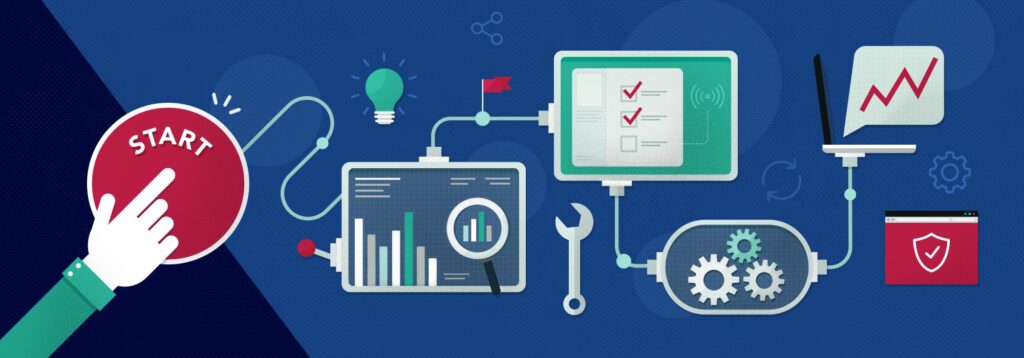How to Overcome The 6 Most Common Challenges
Change is inevitable, especially during a time where we’re seeing massive leaps in business technology powered by big data, machine learning, the cloud, and a shift to remote work. The unprecedented dynamism of digitization requires constant changes and transformation of organizations and their business models. As a study from KPMG show, 96% of all organizations worldwide are undergoing at least one business transformation currently.
To support their transformation initiatives, many IT teams and business leaders are turning to technology change management. They’re aware change is a process and recognize that being in control of that change can help maximize the value of their technology while helping teams work in a consistent, unified way that improves productivity.
Unfortunately, it’s common for technology change management to be a bumpy road. Out of all the businesses undergoing transformation, only 47 % expect to realize sustainable value from their efforts, due in large part to the fact that the road to change is rife with challenges. Any of these roadblocks can cause your entire change infrastructure to crumble, leaving you with wasted effort and lackluster results.
There are six challenges that businesses tend to encounter in their technology change management plans — let’s take a look at what these challenges are, and how to overcome them.

1. Ensuring Organizational Readiness
When a business goes through change — technological or otherwise — the impacted groups within the organization need to be prepared and ready for it. A large change with severe impacts will require a more comprehensive assessment of organizational readiness, whereas a minor change won’t require as much heavy lifting. However, business leaders should always anticipate that a change will be more disruptive than they thought or else employee productivity and satisfaction could plummet.
To ensure your team is ready for change, conduct a change readiness assessment. This assessment will help you get a read on how ready your organization is for the proposed technological initiative, taking into account things like awareness, receptiveness, and capacity. Specifically, you should assess:
- The culture of the group set to undergo the change
- Other current changes within the organization
- Leadership styles of managers within the group
- How aware and willing the group is to support the change
- The outcome of previous projects or changes
- How ready the group is for the transition in terms of knowledge, skill set, policies, etc.
By making these assessments, you’re providing the project team with insights into organization-specific challenges and opportunities that could arise during the process of change. For example, one group might feel overwhelmed with too much change already, meaning they will require more support than a group that is fully on board with the transition. A readiness assessment helps determine any communication and training that will be required.

2. Snags in Communication
Communication is the single most important step throughout the entire change management process, but nevertheless, it is unintentionally ignored by many organizations. Employees are often surprised by new technology appearing on their PC, and due to a lack of two-way communication, may feel unable to share their thoughts on the change. This can cause resistance that can throw your entire strategy into a state of disarray.
Communication planning is a great way to confront challenges with the change strategy before they begin. It starts with carefully analyzing the audiences, the critical messages, and when those messages will be delivered. It’s key that the change management team or project leaders design a communication plan that addresses everyone impacted and also ensures the accessibility for everyone, from supervisors and executives to frontline employees, as each will have particular needs and messaging based on their role in the upcoming change.
This can be done in various ways, including:
- Regular meetings with those within the organization to discuss upcoming changes, collect feedback, and schedule changes in a way that will provide the least disruption to the operation.
- Regular emails keeping the impacted groups up to date on upcoming and scheduled changes.
The creation and sharing of a documented change schedule so that everyone involved can find information about the upcoming changes.

3. Getting Executive Buy-In
When it comes to technological changes, business executives and leaders play a critical role. If your IT team takes ownership over a strategy without getting the approval of upper management, their plans could be met with noncompliance and quickly fizzle out. In fact, according to the Project Management Institute, sponsorship from upper management is the number one success factor in determining project and change initiative success.
Don’t just get executive teams to support your ideas from afar, either. They should have a visible, hands-on role that contributes to the success of the change. Senior business leaders must be actively involved throughout the process, communicating directly with employees while building support from others within the organization.
To guide the activities of upper management, create a sponsorship roadmap that outlines not only how you will communicate the importance of sponsorship to executives, but also how they can help build a network of support that extends throughout the company. This will prove to be a key element in the change’s success.

4. Training Quality
Implementing new technology is no small feat and effective training is the cornerstone to the success of your organization moving forward. However, far too many of these trainings are designed primarily to share a solution’s features, with little consideration toward learning. Everyone learns differently, and rushing through training can result in some employees retaining little to no information.
For a successful implementation, it is crucial to involve all affected employees and transform them into active participants in the change process. Once the affected group has been made aware of the need for change and has expressed their support for the change, project teams must work with their leader to develop training requirements based on the group’s current skills, their knowledge of the new solution, and the knowledge required to successfully implement the change. The focus should be on everyday scenarios that promote, improve or facilitate efficient collaboration and communication within the group.
Additionally, keep in mind that everyone learns differently. When creating learning content for the new technology, be sure to support different learning preferences while allowing employees to independently practice with the software.

5. Managing Resistance
Not every employee will always be completely on board with every change, meaning there’s the chance you will encounter some form of disagreement or resistance. This is normal, but resistance can threaten the success of implementing a change if it’s not proactively addressed. Employees may feel like they are not being heard, especially if there is no avenue to provide feedback, and quickly backslide into old habits.
First, create a resistance management plan that identifies possible points of resistance and how they can be managed throughout the process, including how leaders can help implement these proactive steps within the impacted group — before they become bigger issues. Then, project leaders should reach out to employees after the change has been implemented to gather ongoing feedback on the transition — what’s working, what pain points need to be addressed, and what steps are needed to address these issues.
Not only does this help with a successful implementation of the change from a leadership standpoint, but it also shows those impacted throughout the organization that their thoughts and ideas are valued and taken into account.

6. Optimizing the Plan
Ongoing maintenance of a change management strategy is often overlooked, which ultimately comes as a detriment of an organization’s adoption rate. If you do not regularly review, revise, and gather data, it’s impossible to know if your change management strategy is actually working effectively. Furthermore, it can hinder your ability to build future change management strategies.
By reviewing and revising your change management strategy, you’ll have a better idea of which parts were a success and which parts are in need of improvement. When reviewing your plan, consider the following:
- How long it took to implement the change
- Whether or not regular operations were disrupted
- Any incidents that occurred throughout the process
- How much resistance was encountered and ways to mitigate it in the future
This information can be used to identify and remove any roadblocks in future technological changes, all while also providing you a way to recognize the success of the project and acknowledge everyone’s hard work and involvement — which is an essential part of any project and change.

Embracing the Change
Once your strategy has been implemented, you’re likely to experience a few roadblocks when you implement the change strategy since encouraging employees to adopt new technology is often easier said than done. However, by identifying challenges ahead of time and creating a change strategy that confronts those challenges from the start, you can make the adoption process simpler for every employee. And of course, satisfied employees mean satisfied customers — which translates to a great bottom line.


